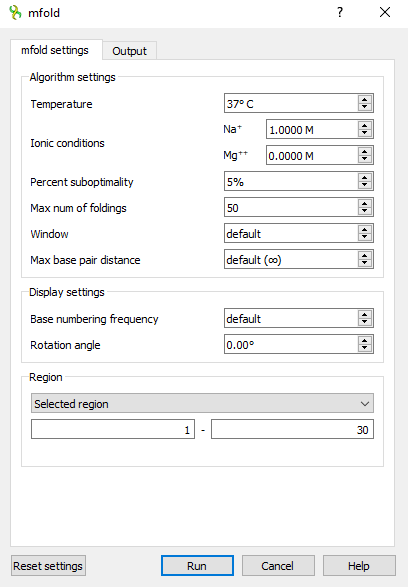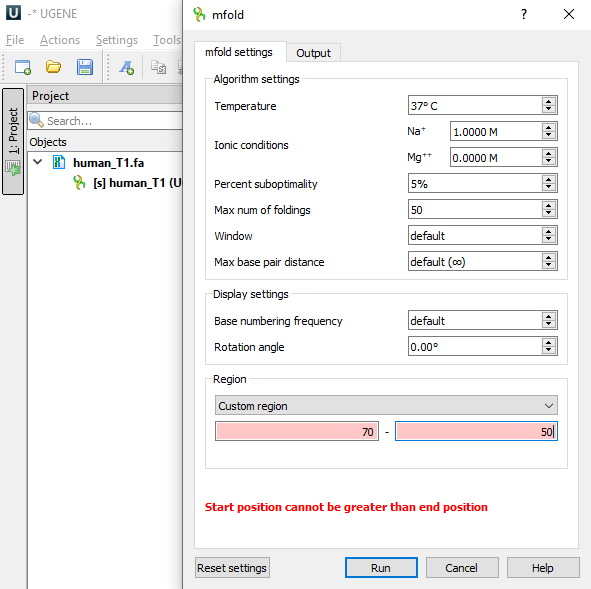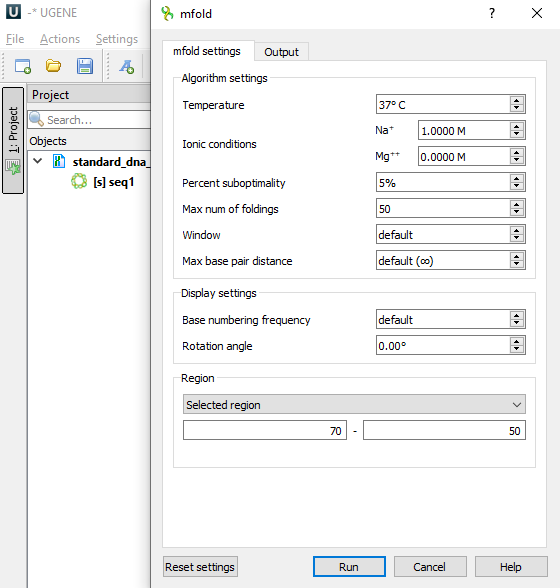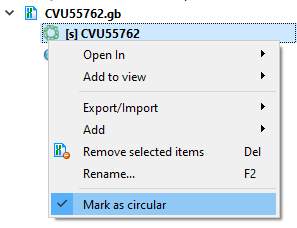...
This is what the mfold dialog looks like
| Anchor | ||||
|---|---|---|---|---|
|
Input parameters
...
If several regions have been selected in a sequence (using the GenBank format), then the dialog will only accept the first of them. The remaining selected regions are ignored. But there is an exception: if the sequence is marked circular and the region passing through the end/beginning is selected, then such a region is considered as a whole region and mfold will be launched on it as on an ordinary piece of the sequence (2 parts of the region – one that goes to end and another that starts from the beginning of the sequence – will be combined into one sequence and analyzed). This is the only case where the start of a region can be greater than the end:
| Anchor | ||||
|---|---|---|---|---|
|
The length of the region in this case 70..50 depends on the sequence length.
...
| Parameter | Default | Description | |||||||||||
|---|---|---|---|---|---|---|---|---|---|---|---|---|---|
| Save output to | /path/to/sequence/ | The folder where the "mfold" subdirectory will be created with the output data in it. By default, this folder is the same as the folder where the input sequence is stored. For example, let's say our OS is Windows and the analyzed sequence has the path "C:\path\to\sequence\my_sequence.fa". After running the task, the folder structure will look something like this
Anchor | dpi | dpi | DPI | 96 | Setting up the Ghostscript converter from PS files to PNG. Quality of saved images (PNG files). The higher this parameter, the higher the quality, size and resolution of the resulting images.
|
Internal parameters
Settings that the user cannot explicitly influence.
...
| 96 | Setting up the Ghostscript converter from PS files to PNG. Quality of saved images (PNG files). The higher this parameter, the higher the quality, size and resolution of the resulting images.
|
Internal parameters
Settings that the user cannot explicitly influence.
- Molecule Type (DNA/RNA). mfold gets sequence information from command line arguments. Information about what type will be passed to the tool can be seen next to the sequence name
- Molecule Topology (linear/circular). mfold gets sequence information from command line arguments. If the sequence is marked as circular, then mfold will work with it as a circular one. Otherwise, as with linear one.
Whether the sequence is linear/circular is described here.
Part of a circular sequence will also be considered a circular sequence. If you want to change this behavior, uncheck "Mark sequence as circular" and then call the mfold dialog.
DPI of images in UGENE. Ghostscript has a default DPI of 72. Therefore, this value is used for images for the internal UGENE report and this value cannot be changed.Anchor internal-dpi internal-dpi
Saving/resetting dialog state
Some dialog fields retain their state between dialog calls. For such fields, the ability to reset settings is also available (the "Reset settings" button at the bottom left in the screenshot of the dialog). Below is a table showing which states are saved between dialog calls and which of them can be reset to default values.
| Save states | Reset states | |
|---|---|---|
| Algorithm settings | yes (it can be tedious to enter fields every time) | yes |
| Display settings | ||
| Region | no (since the region is optionally selected manually by the user) | no (the same reason) |
| Output settings | yes | no (these unique settings are changed manually by the user when the user really needs it; a quick reset only makes sense for algorithmic settings) |
| Info |
|---|
States are saved only for a specific sequence window. Thus, if you have two windows (or two views) for sequence-1 and one window for sequence-2, then each window will have its own state for the mfold dialog. |
Output data
There are 3 types of output from the mfold task in UGENE:
...




